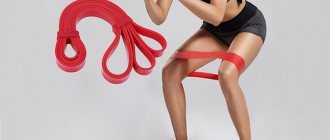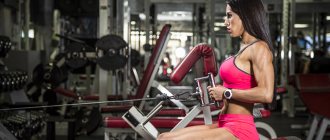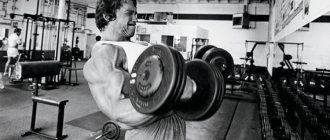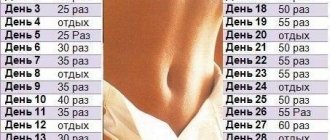Author: Timko Ilya - the ruler of the entire site and fitness trainer | more details >> Rod. 1984 Trained since 1999 Trained since 2007. Author and creator of the site tvoytrener.com. CCM in powerlifting. Champion of Russia and South Russia according to AWPC. Champion of the Krasnodar region according to IPF. 1st category in weightlifting. 2-time winner of the Krasnodar Territory championship in t/a. Author of more than 700 articles on fitness and amateur athletics. Author and co-author of 5 books.
Place in the author rating:
out of competition
(become an author)
Date:
2014-03-13
Views:
753,218
Rating:
4.8
| All articles by the author >> | Medals articles >> |
Articles are loading...
| Article medals: | article in TOP 100 | more than 100 comments | more than 500 thousand views |
Why medals are given to articles:
| Bronze medal: | |
| 1. The article is in the TOP 100 2. The article has more than 3. The article has more than 100 | |
| Silver medal: | |
| 1. The article is in the TOP 50 2. The article has more than 3. The article has more than 500 | |
| Gold medal: | |
| 1. The article is in the TOP 10 2. The article has more than 1 3. The article has more than 1,000 | |
People often come to me with the question: “Help me create workouts for myself.” I have a slightly negative attitude towards such amateur activities, but I understand that it was, is and will be. Since not everyone has money for a coach. And there are also people who fundamentally want to do everything themselves. And there are gyms where there simply is not a single trainer. Or there is not a single intelligent coach (which is not so uncommon).
In general, be that as it may, anyone who has at least a few months of training experience behind them is quite capable of creating their own personal plan. But if you are a complete beginner, then it will be much more difficult for you. After all, you don’t even know which muscles are trained by this or that exercise.
Therefore, I recommend that such people use ready-made programs from this site. Well, for everyone else who wants to play the “be your own coach” game, let’s start slowly. And the first thing you must do:
Where to begin
To create a training program, get a training diary. This could be a classic notebook or an electronic application on your phone.
In addition, you will need to thoroughly reconsider your diet. Now you will have to eat completely differently. There is simply no other option. Go to the gym and eat? doesn't make sense. If you are ready for difficulties, read on?.
There are 3 approaches to creating a training program:
- Take someone’s training program as a standard and work according to it without changing anything.
- Based on certain rules, independently create a training program that will suit the majority of girls in the gym.
- The right way is to develop your own training program from scratch, through trial and error. This is the only way you will gain invaluable knowledge that not a single blogger or coach will tell you about, even if he works with you personally.
Gym Training Basics
As in any other sport, classes in the gym for girls are built on certain principles:
- Load level (100%, 80%, etc.) . You must understand exactly how much weight you are working with and whether you will have the strength to repeat the exercise.
- Number of sets and repetitions . If you are growing muscle mass, then 3-4 sets of 8-12 repetitions. If you are developing strength, then 3 sets of 1-6 repetitions (we are talking about the male half of the gym, this does not apply to girls). To maintain form, each exercise should consist of 3-4 sets of 15-20 repetitions.
- Rest between reps . Usually the body has time to rest in 1-2 minutes. Sometimes when working with heavy weights, the time can increase to 3-4 minutes.
Classification of exercises
The next step is choosing exercises. By type of physical activity they are divided into:
- Anaerobic. These are strength exercises - the energy of muscle contractions comes from the use of creatine phosphate and glycogen, along the path of anaerobic glycolysis with the subsequent formation of lactic acid.
- Aerobic. These are cardio exercises. The body is provided with energy from glucose, glycogen and fatty acids, which, when oxidized, release adenosine triphosphate (ATP).
- Complex. A combination of strength and cardio exercises. The body is provided with energy, which is generated as a result of the consumption of fats, creatine phosphate and glycogen. In this case, two types of glycolysis are used: aerobic and anaerobic.
Interesting fact. Usually in gyms they choose anaerobic exercise, which involves the use of various weights. Such exercises do not promote fat burning, but help build muscle mass.
If you plan to lose weight, your training program should consist primarily of aerobic or cardio exercise. Only in this case can you achieve “melting out” of fat.
The following complex exercises, performed on a stepper, treadmill and exercise bike, are perfect for training. For improved results, it is worth combining them with stepping onto a bench, climbing stairs and jumping out of a low squat. By skillfully combining them, you can create a simple but effective workout.
To increase muscle mass, we give preference to standard strength training:
- Deadlift.
- Bench press lying on a horizontal bench or in French.
- Squats with a barbell on your shoulders.
- Biceps with straight bar.
- Upper block rows with a wide or narrow grip.
- Hand placement, etc.
If, in order to “dry out”, achieve beautiful relief and endurance, you should pay attention to CrossFit:
- High jump.
- Deadlift with light weight.
- Pull-ups on bars or bar.
- Dips.
- Barbell curls for biceps.
- Leg raises on the bar (they must be straight).
What does the training program consist of?
To create a program, you will need two types of training:
- power;
- cardio.
Power training
Strength training is a set of physical exercises to develop strength and build muscle mass. To do this, exercises are “weighted” with dumbbells, a barbell, etc.
pros:
- improvement of muscle tone, in particular, the general appearance of the figure;
- getting rid of extra pounds (strength training in this regard is much more effective than cardio);
- strengthening ligaments, tendons, joints;
- increasing immunity.
Minuses:
- at first it is difficult for girls to perform a whole range of strength exercises;
- if the load is exceeded, injuries may occur;
- With the wrong technique, you can pump up the wrong muscles.
Rules for strength training
- Calculate your training time. The duration of the training is no less than 40 minutes and no more than 1 hour.
- Plan the amount of exercise. The optimal number of exercises is 4-8 per workout.
- Maintain the number of repetitions and sets. Do each exercise in 3-4 sets of 6-12 repetitions.
- Choose the right weight. Weighting with which you can repeat the exercise up to 12-15 times is considered suitable.
- Take a rest. After each strength exercise, rest for 1.5-2 minutes.
- Watch your breathing. Maximum muscle tension should be while exhaling. Relaxation - while inhaling.
- Don't exercise on an empty stomach. But don’t overeat before class. The best option is a light and healthy lunch 1.5 hours before training.
- Increase the weight of your exercises regularly. That is, if you squatted with a barbell weight of 20 kg for 3 sets of 12 repetitions, then increasing the load to 21 kg in the same number of sets and repetitions means progress in training.
Cardio training
The main goal of such training is weight loss. This includes strengthening the cardiovascular system. Cardio classes in the gym include the following types of exercises:
- running or walking on a treadmill;
- exercise on an exercise bike;
- jumping rope;
- stepper exercises.
pros:
- strengthening the cardiovascular system;
- giving tone to all muscles of the body;
- high energy consumption in combination with strength exercises.
Minuses:
- cardio does not give beautiful muscle definition;
- Fat burning stops at a certain stage.
The main disadvantage of cardio training is that immediately after the end of the session, the fat burning process stops. After strength training, it lasts for 24-48 hours after training!
There is only one way out - you need to correctly combine both types of loads in your training program: cardio and strength.
Warm-up and cool-down are the main components of training
Be careful about warming up before training, especially strength training. This will help you avoid injuries that will put you out of action for a long time.
Warm-up consists of several stages:
- Warm up the joints. This includes: rotation of the head, arms, legs and body 4-8 times in each direction. Then bend over to each leg.
- Cardio for 5-10 minutes. Any type of cardio exercise is suitable: treadmill, exercise bike, stepper.
- Each new strength exercise should begin with a warm-up. To do this, perform the first set with a weight of 50% of the maximum.
Many girls immediately after training run to the shower, without allowing their body to “cool down”. Cooling down, in turn, allows you to quickly start the recovery process. To do this, it is enough to do light stretching for each muscle group for 5 minutes.
How to regulate training load?
If muscle soreness has disappeared within 48 hours after the first lesson, you can perform 3 sets of each exercise in the second lesson.
With normal load tolerance, it is allowed to perform 6-10 exercises in the main part of the lesson, 2-3 approaches with a rest of 2-3 minutes (until calm breathing is restored) .
The exercises are performed sequentially, that is, the transition to another exercise is carried out after completing all approaches of the exercise.
The number of repetitions per approach is 8-12. In the first approach, at least 12 repetitions are performed, and in the last, at least 8 repetitions. If in the last approach you can do 12 repetitions, then in the next lesson the load must be increased.
How to create a training program depending on your goal
Any program is built on a combination of these two types of training. To do this, you need to decide on the main goal :
- You want to lose weight and slightly shape your figure.
- You dream of getting the biggest butt, especially if you've never had one (or other body parts).
- You go to the gym to keep yourself in shape.
Depending on the task at hand, certain exercises are selected, their order, and quantity. Then an individual program is developed.
In addition to the main goals, set specific tasks for yourself. For example, lose 4-5 kilograms in a month . A positive result will motivate you further.
Goal 1: weight loss
Your plans do not include building muscle mass. You just want to lose weight. Then combine cardio exercises with strength exercises. Cardio will help you lose calories faster, and strength training will keep your muscles toned and tighten your figure.
Training frequency . 5 days a week: 3 for strength training and 2 for cardio. In the latter case, it is enough to exercise for 45–60 minutes on one of the cardio machines. The number of repetitions in each exercise is 15-20.
Another option is high-intensity circuit training. Duration 20–30 min.
Nutrition . The main task is to create a calorie deficit. To do this, it is enough to consume 300-500 calories less than the daily norm, taking into account your activity.
Goal 2: Muscle Growth
In this case, highlight strength exercises. Cardio should only be included in your training program if you have excess body fat.
Training frequency . 3 strength training sessions per week with constant progression in weight. The number of repetitions in each exercise is 8-12. The break between classes must be at least two days.
Nutrition . Enrich your diet with protein foods, and also increase the amount of slow carbohydrates. To grow muscles you need to increase your calorie intake. For girls, this is 300-500 additional calories per day.
What might a standard lesson look like for 1 month of training?
The exercises of the program are performed at each lesson, they can be swapped, but you cannot constantly change one exercise to another.
Warm-up • 10 minutes any cardio machine
Main part 1. Leg press 3 (sets) X 8-12 (reps) 2. Calf curls 3 X 8-12 3. Horizontal row 3 X 8-12 4. Push-ups 3 X 8-12 5. Vertical row 3 X 8=12 6. Seated press in the simulator 3 X 8-12 7. Hyperextension 3 X 12-15.
Cool down • 10 minutes, any cardio machine; 2 – 3 stretching exercises
Goal 3: Keep fit
If you are in good shape, your goal is to maintain it. A combination of cardio and strength training in one session will help you.
Training frequency . 3 strength training sessions per week. Each session should end with 15-20 minutes of cardio exercise. The number of repetitions in each exercise is 12-15.
Nutrition . It is better to introduce more vegetables and fruits into your diet. And don’t forget about proteins, add them to your food at the rate of 1.8 g of protein for every kilogram of your weight.
IV. Decide on a set of exercises
Write down all the exercises you want to do during your workouts. Moreover, it is better to immediately sort them by muscle groups. If you do not have enough experience, then problems may arise with this due to basic ignorance of anatomy and biomechanics. Well, as a hint, you can look at the article: What exercises are basic. Or use MENU – EXERCISES. Where they are already sorted by body parts.
The amount of exercise can vary greatly depending on your goals and amount of training. Let's say, if you train 2 times a week to stay in shape using a combined method, then 10 basic exercises (5 per workout) will be enough for you. If you are actively losing weight with supersets of 5 workouts per week, then the number of exercises can be 40 or even more.
Cardio training program
Cardio training is used to speed up the burning of excess fat. For cardio, it is better to set aside several separate days a week. In this case, you will have to go to the gym 5 days a week: 2-3 times for strength training, 2 times for cardio.
If you can’t go to the gym that often, then do cardio immediately after strength exercises. Then classes will be held 2-3 times a week.
Cardio options:
- on exercise machines (treadmill, exercise bike, airbike, ellipse);
- circuit cardio training.
Option 1. Cardio training on machines
Choose a trainer depending on your body mass index. If your body mass index is normal, then treadmills and any other exercise equipment are suitable. If it is more than normal, then it is better to stop running on the treadmill, otherwise the joints will be severely overloaded.
Option 2. Circuit cardio training
Circuit training involves performing exercises for different muscle groups one after another in a circle. The intensity of the exercise is high, but at the same time some muscles rest while others work.
The benefits of circuit cardio training:
- there is no monotony, as when working on simulators;
- no equipment is needed: your own weight acts as weight.
- calories are burned intensively.
Example of a circuit cardio workout
Perform 5 circles without a rest break:
- 20 air squats;
- 10 push-ups from knees;
- 20 repetitions of the bicycle exercise;
- 10 burpees;
- 30 seconds plank.
Tip: If your breathing is lost and it’s hard to start the next circle, you can do a 30-second interval.
Principles of effective training
From the book “PSYCHOLOGY IN MODERN SPORTS” by Bryant J. Cratty
| Bryant Jackson Cratty (1929-2008) was a professor of physical education and kinesiology at UCLA and a renowned expert in the field of movement education. Author of a large number of books. |
There is more to being a coach than simply preparing individual athletes or teaching isolated skills. Coaching art presupposes the ability to combine individual skills into a holistic activity.
The success of a season depends on the professional competence of the coach, the level of development of the basic physical qualities of the players and, to some extent, on the working conditions, inventory and equipment. Another important factor in the learning process, which can often tip the scales from failure to success and vice versa, is the interaction and mutual influence of the coach and athletes.
Competitions are not won on the day of the performance. Victories are prepared over many hours and days of intense and intense work. Consequently, it is the quality of these trainings (and not necessarily their duration or even intensity) that plays an important role in the success of an athlete’s performance. Let us note, by the way, that often coaches whose students perform unsuccessfully conduct the most active training on the day of the competition or the day before.
There are several “threads,” or central guidelines, that run through the training process and influence the surrounding psychological and social climate in different ways. In the classroom, the coach also has ample opportunity to motivate, hold, ground, prepare, or confuse the athletes he is working with. Below are some considerations that a coach should specifically pay attention to before, during, and after training.
GENERAL CONSIDERATIONS FOR TRAINING PLANNING
Through research and observation, it has been observed that the best coaches usually plan their training down to the smallest detail, allocating specific time for various exercises, interactions, etc. Creating an accurate and thoughtful plan is an important part of the coach's job, although it should be possible to make appropriate adjustments when unexpected changes in the situation (injuries, weather conditions, etc.).
Regardless of the sport, certain general requirements must be taken into account when developing training plans, including the following:
1. The training should include both physical and psychological warm-up to prepare for subsequent more strenuous work. During this time, the athlete can warm up on his own, communicate with his group (team) mates and get used to the social and physical conditions in which he will work.
2. Daily workouts should contain something new if possible. There is nothing worse than the tedious monotony of training conditions. The desire for something new is one of the most important and inherent human instincts. A serious mistake for a coach would be not to take this into account (see the article “Motivation in Sports”). It must be borne in mind that to create a sense of novelty in training, various approaches can be successfully used: • the sequence of performing individual components of training can be varied daily, that is, in one training session, first perform the exercises and then improve the interaction, in the next - vice versa; • offer participants completely different exercises once or twice a week; • if an element of novelty is required when working on some movement, then you can use a game. Sometimes observed in training, especially when working with children and young people, jokes, unusual behavior and distractions can be considered as a way of creating novelty when the trainer did not specifically provide for the inclusion of this element in the work.
3. Before the start of the proposed training, the coach must inform the athletes about its intensity and duration. When athletes are misinformed or not told at all about the work ahead, then at the very beginning of training their effort and effort will most likely be minimal. In this case, they mentally prepare themselves for the hardest work, for the most difficult training. Even though they are well aware of the intensity of the work, many athletes still exert only moderate effort to be able to complete the entire workout. And only complete information about the intended work minimizes this “layout” effect.
4. The time allocated to holistic activities (for example, in individual sports) or game interactions and individual exercises in training should be balanced. A training session consisting almost entirely of team activities leaves little time to work on individual elements of holistic activities and skills. On the other hand, if too many exercises are used in a workout, it makes it difficult for the athlete to perceive the whole action and can lead to the fact that he will focus his attention on only certain parts of it. The exercises resemble a general situation, for example a game, but in many ways and significantly differ from it. Individual exercises usually do not prepare athletes to exert effort in a holistic movement or action. However, the inclusion of individual exercises in training allows the athlete not only to work on improving skills and abilities or to solve specific problems, but also to introduce a certain variety into the work.
SELECTION OF EFFECTIVE EXERCISES
Apparently, in nothing else do trainers violate the laws of training as often as in the selection and composition of exercises. How a coach decides to use a particular exercise is often, from a psychological point of view, an incomprehensible mystery. Therefore, many exercises are likely to have the opposite effect than intended. In order for exercises to bring maximum benefit, they should not violate the basic laws of transfer of motor skills (see the article “Formation of motor skills”), formulated in the course of experimental studies. The data from these studies made it possible to identify the following main points.
Exercises should, whenever possible, include the exact elements of the movement or skill being improved.
A number of studies have shown that the use of a limited set of coordination exercises by athletes leads to insignificant improvements in their performance of complex motor skills. A coach working with a basketball team must analyze all possible variations of movements of the legs, arms and torso of the defenders, and then develop various “shuttle” exercises that duplicate these movements. A similar analysis should be carried out by coaches in other sports that involve a significant number of complex movements with hand-eye coordination.
Thus, in most sports, training requires a wide variety of exercises rather than just one or two of the trainer's favorite exercises. Exercises should include what the athlete sees in competitive situations while duplicating the movements of the actual competitive skills.
Unreasonable violation of this principle often leads to the use of exercises that not only do not help the athlete in his further performances, but, on the contrary, complicate his interaction in a real game situation.
During training, exercises should be gradually modified in order to ultimately simulate stressful competitive situations.
Similarly, as the skill of performing a certain movement improves, the factor of fatigue should be introduced into the exercises as an additional stressor.
After the initial mastery of the movements, an element of competition should be included in the exercises. Stress, novelty and the element of competition help to increase the athlete's activity and motivation to perform exercises. A creative-thinking coach can find many ways to incorporate an element of competition into regular training. Usually during training, athletes willingly compete with each other. It is therefore advisable to specifically think about the possibilities of such competition.
The athlete must accurately understand the meaning of each exercise and its role in subsequent competitive activity. The athlete needs to be helped to form “bridges of understanding” between specific exercises and the overall movement or activity in which he will participate. Ignoring this rule, perhaps because of the assumption that the athlete already knows why he is doing a particular exercise, often makes the training less effective and does not promote the athlete's activity.
Exercises should simulate the conditions of competitive activity. Care should be taken to ensure that exercises model not only the sensory and perceptual elements of the game (i.e., what the athlete sees and hears), but also psychological stress (the effects of opponents). A coach who offers an athlete exercises that improve reactions to situations other than competitive ones is wasting his own and others’ time.
Research shows that mature, experienced athletes train significantly more actively if they are involved in training planning and exercise selection. Thinking young athletes and more experienced ones often make useful corrections and comments to the coach regarding the modification of individual exercises, training planning and combining individual parts of the training process into a single whole. Many athletes know much more than a coach sometimes thinks about their individual characteristics, motor abilities and physical qualities. Attentive attention to the athlete’s suggestions can often contribute to more productive training and faster mastery of the exercise due to the activity and full dedication of the athlete.
BASIC PRINCIPLES OF TRAINING
The coach is mainly interested in three important things: the intensity with which the athletes work, the quality of their performance and the overall duration of the entire training (with an appropriate amount of time for exercises, interactions and development of the necessary qualities).
From a psychological (if not physiological) point of view, it is advisable to warm up before strenuous work. Studies of the effect of warm-up on subsequent activity indicate inconsistent results. Indeed, it is difficult to determine whether there is any real physical need for warming up before various sports activities. However, a specific warm-up can produce positive psychological effects. Research has shown that athletes who believe in warming up actually benefit greatly from it. It can also act as a way of psychologically influencing an opponent.
The training should be well organized and take place in a business, work environment. The athlete should feel that the coach knows what he is talking about and can focus on what is most important at the moment, rather than searching and figuring out what to do next or how to do it.
The coach must pay attention to the overall pace and rhythm of the workout. As noted earlier, the warm-up period provides psychological acclimatization to the workout. After this, most workouts involve an increase in intensity, followed by a cool-down period, which may be followed by exercises to develop specific qualities. Although traditionally in physical education lessons and training, general developmental exercises are usually carried out at the very beginning, such a practice is erroneous from various points of view. To be truly productive and to cause appropriate changes in the body, exercise involves a certain amount of overload, tension and must, therefore, cause muscular or cardiovascular fatigue in athletes. If such truly general developmental exercises are performed before some specially planned exercises in training, then it is unlikely that the athlete will be able to master them well.
Therefore, it is advisable to give a general developmental load at the end of the training. Caution must be exercised in this regard, since experimental evidence suggests that intense physical exercise after performing complex mental tasks can impair the ability to retain a given mental action in memory. After explaining difficult drills or team interactions (in doubles), some time should be specifically allocated (perhaps an interval during which the coach summarizes the work or makes general comments and assessments) when the players are in a relatively calm state. This technique allows new and often complex ideas and thoughts about a game or activity to gradually “introduce” into the nervous system.
During training, all kinds of rewards and punishments should be used wisely and in a timely manner. The coach must take into account that his students constantly “read” his facial expressions, gestures and simply postures during training. Athletes try to interpret them in all cases - both when the coach praises them and when he makes comments. A coach, like a parent, may not achieve the positive or negative effects of praise or disapproval if used too often. Athletes will constantly expect comments from him, for example, and will never be exactly sure of how they are performing the exercise. A coach can become a laughing stock if he constantly makes incendiary speeches to his players.
The improvement and growth of an athlete's achievements will depend on how often he is paid attention to during training and how often he receives information about his mistakes and successes. During training, the coach must be very attentive, correct the athletes’ mistakes as they appear and prevent them from becoming fixed. Sometimes the coach may even stop the athlete and suggest that he perform an exercise incorrectly so that he can get a better feel for what he should avoid.
Athletes generally do not need constant direction or praise during performance, and they generally do not benefit from it. They need, first of all, professional, intelligent and constructive advice at a critical moment in training, especially at the beginning of the season, when important skills and abilities are just being formed and are beginning to be improved.
Completing the actual workout shouldn't mean stopping the mental work. Intellectual and verbal information, which is part of many sports training, is best retained if, after the information is communicated, some time is allowed for repetition and mastery of it. If the training or part of it ends without such a verbal-intellectual assessment, a summary of what has been done, then it becomes less effective. Athletes at all skill levels should be trained as thinking, conscious people, not robots.
If possible, it is advisable to practice watching videos or film clips together. After the training is completed, the trainer or his assistants evaluate it.
Planning for subsequent workouts should begin immediately after completion of the workout. Assessing what has been achieved and what remains to be done, as well as identifying individual differences in the results of the work done in a particular training session, will help make subsequent training sessions even more effective.
In sports that do not require teamwork, the preparation of an athlete often poses quite a serious problem for the coach, especially if the coach has not planned the work properly. More often than not, an athlete's performance will depend on whether and how often he participates in planning his training with a coach and how well he understands why certain exercises or tools and methods are included in his training.
At least once a week, the coach should schedule “formal” meetings with individual athletes. These meetings can be used to assess the effectiveness of training, the physical and emotional state of the athlete, his attitudes, as well as to plan upcoming work.
There are marked individual differences in how athletes learn material, particularly in the cues they use to master motor skills. Some people master movement best by watching a movie, for others it is more effective to listen to and think about a detailed verbal analysis of an exercise, and, finally, others, after receiving the most general idea of the task, acquire a “sense of movement” directly during its practical implementation. Some athletes can successfully use a combination of these different types of information to master and improve in an exercise.
When a coach works with an athlete, he must adapt his teaching methods to the individual characteristics of his student. To determine what an athlete's focus is when learning a new exercise, a coach can simply ask him and then observe his performance after using different types of training strategies.
It should not surprise the coach if, later in the course of training, the athlete needs reference points that are different from those he used when he first started playing sports or mastered an exercise. Moreover, in individual sports, the athlete has to spend more time on general physical training in the later period of his sports career so that there is no aversion to the movement or motor task itself.
High-level athletes specializing in individual sports often have to spend some time each year at various levels of competition without the presence and direct assistance of their coach. Therefore, sometimes it is advisable for a coach to conduct “isolation training”, during which the athlete works independently for several days, preparing himself specifically for the isolation that he will have to face while competing at important international competitions. Before starting such a training, the coach must explain to the athlete why exactly this is being done. It would be psychologically unjustified to suddenly leave a very dependent, dependent athlete alone.
Often an athlete can be involved in a scientific analysis of the problems of his sport. Many athletes, even without encouragement from a coach, engage in such analysis, read specialized literature, watch films and communicate with specialists who can help them in some way. Athletes who exhibit such a comprehensive understanding of all aspects of their sport typically outperform their competitors who do not exhibit a similar interest in the sport and their sport specialty.
However, it happens that some athletes become either too introspective, withdrawing excessively into their inner world and trying to grasp the “correct” mental state necessary for successful performance (i.e., to a certain extent, they copy outstanding athletes in their sport), or they come into contact with "experts" who often give them dubious advice. The coach and athlete should discuss and jointly outline how best to direct their efforts towards achieving self-knowledge and better assess their physical and psychological characteristics. Working in individual sports, the coach has the opportunity during training to take into account the individual differences and characteristics of his students, adapt to them and increase group cohesion. In a team sport (doubles), cohesion is a necessity that arises during classes and competitions. This becomes especially obvious when the sense of “we” disappears in the team. In individual sports, the athlete needs to be exposed to specific techniques more often in order to develop a desire to work as a team and achieve a common goal.
Typically, the larger the group, the more tolerant it is of authoritarian leadership styles. In a large group, good organization of the work of the coach is appreciated. However, it is also true that as the team grows larger (for example, from a group of 6 tennis players), each member begins to feel that he is making less of a contribution to achieving the overall group goal. Consequently, a coach working with a group faces problems that are somewhat different from those faced by a coach working with individual athletes who are more concerned with their own performance in one event.
The size of the group should not prevent the coach from taking into account the individual characteristics of the movement. Each person seems to have distinct tendencies towards a certain speed of movement, the desired space in which he moves, and the tempo of rhythmic movements. (At the same time, there is a huge amount of research indicating the preference for movements of the arms or legs, as well as left- or right-sided movement of the whole body.) Master trainers should not be surprised by individual differences, and should provide for the possibility of modification by group members of standard ways of performing the movement. The main criteria here should be the ease of mastering the skill by the athlete and its effective and successful implementation.
All group members should be able to recognize and discuss individual differences that exist. Athletes who perform well as individuals, for example in tennis, will always perform well in pairs. The main thing that determines success is clear interaction with each other. In many sports, team members must be well aware of their teammates' characteristics and capabilities (speed and spatial preferences) so that they can anticipate where their partners will be and what their intentions will be. This will allow for greater consistency in the team's game interaction.
There should be no hostility or animosity between team members during training. Sports teams whose players view practice as a social situation and a way to spend free time tend to perform less successfully than teams whose goal is to achieve high performance.
Sometimes, some athletes with a high need to achieve an excellent result become irritated and react negatively to their partners who have less pronounced needs for achievement or the level of preparedness to successfully achieve a team goal is lower than required. It should be noted that in teams where players constantly argue with each other, there is rarely a good emotional climate. Excessive intragroup tension distracts athletes’ attention from activities and requires additional, sometimes significant, efforts on the part of the coach and leaders. However, there is an optimal level of tension that is not only acceptable, but also desirable for enhancing activity.
Training players in team tactics should be as lively as possible, using various methods. Team members must know the general and specific approaches to the work of a coach, the game plan, and the tactical principles that guide the coach when making decisions. Thanks to this, in difficult competitive situations, when it is necessary to make certain tactical decisions, the cohesion of the team and its spirit are preserved.
Team members must acquire a taste for team play, tactical formations and the strategy used, and gain a deeper understanding of the meaning of the team’s attacking and defensive tactics. Tactics training can be carried out using verbal analysis of specific situations or practical playback of episodes with subsequent correction of actions by the players themselves.
SUMMARY
Effective training in team and individual sports must be well planned and interesting, and its goals and objectives, the content of the material, are known to the athletes. Good exercises are those that take into account all the parameters of competitive motor skills improved during training. Workouts that are interesting for athletes and therefore more productive include elements of novelty, an optimal balance of exercises and team interactions, and work on the holistic movements that will be performed in competition.
The coach's behavior during training should be businesslike. It must provide the necessary support to athletes and provide them with timely information. Effective training in training involves taking into account individual differences in the mastery of material and motor abilities of athletes.
Special means, methods and activities should be used during training to help athletes in team performances form a sense of “we” in the team. In team sports training, in addition, it should also be possible to organize work taking into account negative or positive interpersonal influences that may arise between partners.
| Other materials on this topic: | Formation of motor skills | Motivation in sports |
Briefly about the main thing
If you carefully study the material, it will not be difficult for you to create a training program yourself. I will list the main points:
- Decide on your goal: losing weight, maintaining muscle tone, building muscle mass.
- Choose one of the strength training options. Change the program at least once every 3-6 months.
- Choose the best cardio workout for yourself.
- Develop a workout schedule taking into account the required strength and cardio load.
- Make a meal plan for every day. Half of the success depends on its quality.
- Get enough sleep. You should spend at least 7-8 hours in bed.
That's all. Now you know how to properly create a training program. And be sure to keep a fitness diary that will allow you to track and analyze the results of your workouts in the long term.











